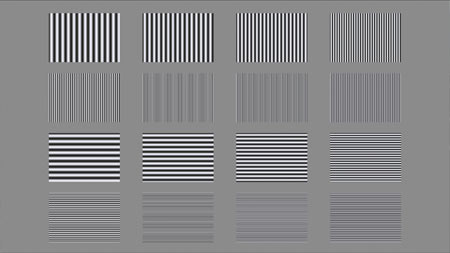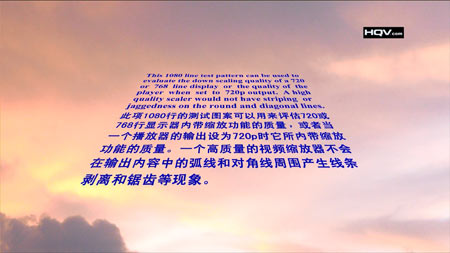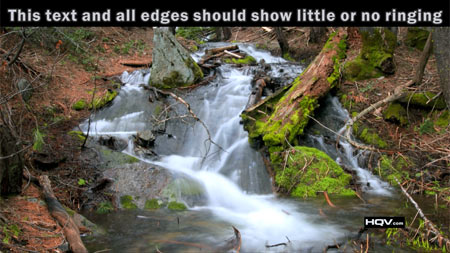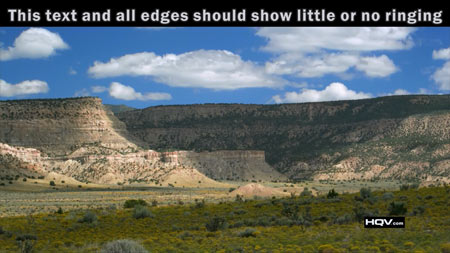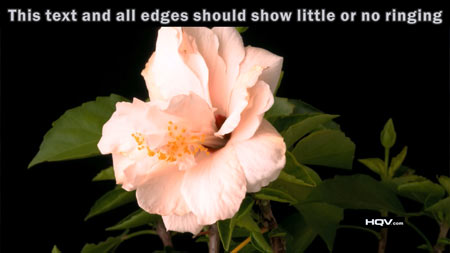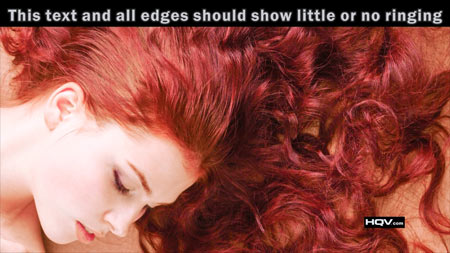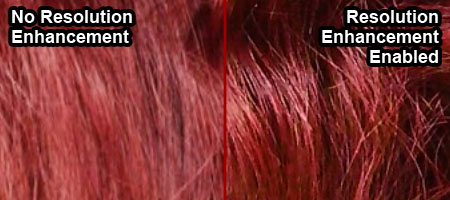Video Quality Tested: GeForce Vs. Radeon In HQV 2.0
Test Class 3: Image Scaling And Enhancements
This class puts the video processor’s scaling and resolution enhancement abilities to task.
Chapter 1: Scaling and Filtering
These tests use 1080p test patterns to assess the video processor’s ability to scale and filter video. There are three tests in this chapter: the first two are simply static and moving-frequency band test patterns, while the third is made up of vanishing text. To perform these tests properly, the video must scale, so we’re running these tests at a 1280x720 resolution. This forces the video processor to scale down the 1080p source to fit a 720p output signal.
Tests A and B: Luminance and Chrominance Frequency Bands
The first two tests are luminance frequency bands and chrominance frequency bands. The full five points are earned if the bands have uniform patterns and there’s no ringing or ghosting. This is reduced to two points if some non-uniform or attenuation is present only on the highest band, or if there’s mild faint ringing or ghosting. Zero points are awarded if there’s heavy ringing or ghosting and uniformity problems with the lower bands.
The scoring criteria can be subjective here if any ringing or ghosting is seen at all, but we aren’t able to make out any problems with any of the hardware. As such, we’ve scored all of the graphics cards with the full five points.
| Frequency Band Scaling Test Results (out of 5) | |||||
|---|---|---|---|---|---|
| Row 0 - Cell 0 | Radeon HD 6850 | Radeon HD 5750 | Radeon HD 5670 | Radeon HD 5550 | Radeon HD 5450 |
| Luminance Bands | 5 | 5 | 5 | 5 | 5 |
| Chrominance Bands | 5 | 5 | 5 | 5 | 5 |
| Header Cell - Column 0 | GeForce GTX 470 | GeForce GTX 460 | GeForce 9800 GT | GeForce GT 240 | GeForce GT 430 | GeForce 210 |
|---|---|---|---|---|---|---|
| Luminance Bands | 5 | 5 | 5 | 5 | 5 | 5 |
| Chrominance Bands | 5 | 5 | 5 | 5 | 5 | 5 |
Test C: Vanishing Text
Get Tom's Hardware's best news and in-depth reviews, straight to your inbox.
In the vanishing text test, the scene shows a cloudy background with moving text entering from the bottom of the screen and shrinking toward a vanishing point as it moves upward—think the Star Wars movie intros. If the video processor scales the text without striping or stepping artifacts, five points are awarded. If there is slight striping, stair-stepping, or ringing artifacts on the edge of characters, the score is reduced to two points. Zero points are awarded if these problems are noticeable.
Once again, the test scoring criteria is worded a little ambiguously. As with the previous test, we aren’t able to make out any problems with any of the tested graphics cards, so all of the graphics cards we’re testing are awarded the full five marks.
| Vanishing Text Test Results (out of 5) | ||||
|---|---|---|---|---|
| Radeon HD 6850 | Radeon HD 5750 | Radeon HD 5670 | Radeon HD 5550 | Radeon HD 5450 |
| 5 | 5 | 5 | 5 | 5 |
| GeForce GTX 470 | GeForce GTX 460 | GeForce 9800 GT | GeForce GT 240 | GeForce GT 430 | GeForce 210 |
|---|---|---|---|---|---|
| 5 | 5 | 5 | 5 | 5 | 5 |
Chapter 2: Resolution Enhancement Tests
Upscaled video can have scaling and filtering problems, but it will also lose detail and appear softer or blurrier. This chapter consists of a single test comprised of five different scenes: a brook, a mountain, a time-elapsed flower bloom, red hair, and wood grain.
A single score is based on evaluating the entire sequence of images. The full 15 points are awarded for fine details that are more distinct and three-dimensional without bright or dark outlines introduced around characters or objects. This is reduced to 10 points if detail is increased but some outlines are introduced, and five points if mild outlines are present. No points are awarded if no enhancement detail is observed, or if the enhancement looks coarse and artificial.
All of the cards that are powerful enough to handle edge enhancement manage a perfect 15 points in this test. The only exception in our test group is AMD's Radeon HD 5450.
| Resolution Enhancement Test Results (out of 15) | ||||
|---|---|---|---|---|
| Radeon HD 6850 | Radeon HD 5750 | Radeon HD 5670 | Radeon HD 5550 | Radeon HD 5450 |
| 15 | 15 | 15 | 15 | 0 |
| GeForce GTX 470 | GeForce GTX 460 | GeForce 9800 GT | GeForce GT 240 | GeForce GT 430 | GeForce 210 |
|---|---|---|---|---|---|
| 15 | 15 | 15 | 15 | 15 | 15 |
Current page: Test Class 3: Image Scaling And Enhancements
Prev Page Test Class 2: Noise And Artifact Reduction Next Page Test Class 4: Adaptive ProcessingDon Woligroski was a former senior hardware editor for Tom's Hardware. He has covered a wide range of PC hardware topics, including CPUs, GPUs, system building, and emerging technologies.
-
jimmysmitty I second the test using SB HD graphics. It might be just an IGP but I would like to see the quality in case I want to make a HTPC and since SB has amazing encoding/decoding results compared to anything else out there (even $500+ GPUs) it would be nice to see if it can give decent picture quality.Reply
But as for the results, I am not that suprised. Even when their GPUs might not perform the same as nVidia, ATI has always had great image quality enhancements, even before CCC. Thats an area of focus that nVidia might not see as important when it is. I want my Blu-Ray and DVDs to look great, not just ok. -
compton Great article. I had wondered what the testing criteria was about, and Lo! Tom's to the rescue. I have 4 primary devices that I use to watch Netflix's streaming service. Each is radically different in terms of hardware. They all look pretty good. But they all work differently. Using my 47" LG LED TV I did an informal comparison of each.Reply
My desktop, which uses a 460 really suffers from the lack of noise reduction options.
My Samsung BD player looks less spectacular that the others.
My Xbox looks a little better than the BD player.
My PS3 actually looks the best to me, no matter what display I use.
I'm not sure why, but it's the only one I could pick out just based on it's image quality. Netflix streaming is basically all I use my PS3 for. Compared to it, my desktop looks good and has several options to tweak but doesn't come close. I don't know how the PS3 stacks up, but I'm thinking about giving the test suite a spin.
Thanks for the awesome article. -
cleeve Reply9508697 said:Could you give the same evaluation to Sandy Bridge's Intel HD Graphics?.
That's Definitely on our to-do list!
Trying to organize that one now.
-
lucuis Too bad this stuff usually makes things look worse. I tried out the full array of settings on my GTX 470 in multiple BD Rips of varying quality, most very good.Reply
Noise reduction did next to nothing. And in many cases causes blockiness.
Dynamic Contrast in many cases does make things look better, but in some it revealed tons of noise in the greyscale which the noise reduction doesn't remove...not even a little.
Color correction seemed to make anything blueish bluer, even purples.
Edge correction seems to sharpen some details, but introduces noise after about 20%.
All in all, bunch of worthless settings. -
killerclick jimmysmittyEven when their GPUs might not perform the same as nVidia, ATI has always had great image quality enhancementsReply
ATI/AMD is demolishing nVidia in all price segments on performance and power efficiency... and image quality.
-
alidan killerclickATI/AMD is demolishing nVidia in all price segments on performance and power efficiency... and image quality.Reply
i thought they were loosing, not by enough to call it a loss, but not as good and the latest nvidia refreshes. but i got a 5770 due to its power consumption, i didn't have to swap out my psu to put it in and that was the deciding factor for me. -
haplo602 this made me lol ...Reply
1. cadence tests ... why do you marginalise the 2:2 cadence ? these cards are not US exclusive. The rest of the world has the same requirements for picture quality.
2. skin tone correction: I see this as an error on the part of the card to even include this. why are you correcting something that the video creator wanted to be as it is ? I mean the movie is checked by video profesionals for anything they don't want there. not completely correct skin tones are part of the product by design. this test should not even exist.
3. dynamic contrast: cannot help it, but the example scene with the cats had blown higlights on my laptopt LCD in the "correct" part. how can you judge that if the constraint is the display device and not the GPU itself ? after all you can output on a 6-bit LCD or on a 10-bit LCD. the card does not have to know that ... -
mitch074 "obscure" cadence detection? Oh, of course... Nevermind that a few countries do use PAL and its 50Hz cadence on movies, and that it's frustrating to those few people who watch movies outside of the Pacific zone... As in, Europe, Africa, and parts of Asia up to and including mainland China.Reply
It's only worth more than half the world population, after all. -
cleeve mitch074"obscure" cadence detection? Oh, of course... Nevermind that a few countries do use PAL and its 50Hz cadence on movies...Reply
You misunderstand the text, I think.
To clear it up: I wasn't talking about 2:2 when I said that, I was talking about the Multi-Cadence Tests: 8 FPS animation, etc.
